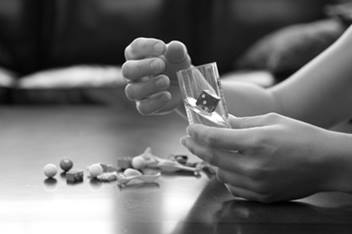Poisoning
There are more than 2.4 million poison exposures every year in the United States. Because young children are always placing objects in their mouths, more than half of all poisonings occur to children younger than 6 years.
Poison Prevention
A poison is something that can make you sick if you eat, drink, touch, or breathe it. Poisons can be found everywhere in the home, and even seemingly harmless items can become dangerous if swallowed. Poisonings happen every day. Therefore, it is important for parents to recognize poisons, keep them locked up, and know what to do if a child does come in contact with a poison. Poison prevention and immediate treatment are key in keeping your child safe.Common Causes of Poisoning in Children
- Cosmetics and personal care items
- Medicine and vitamins
- Cleaning and laundry products, furniture polish, and lamp oil
- Car fluids - antifreeze, windshield wiper fluid, and gasoline
- Bug and weed killers, fertilizers, and plants
- Batteries
- Alcohol
- Carbon monoxide and lead
- Arts and crafts supplies
Treatment
- If your child is unconscious, not breathing, or having seizures, call 9-1-1 or your local emergency number immediately.
- If your child is breathing, but you suspect he may have swallowed something poisonous, contact the Poison Control Center at 1-800-222-1222. Keep this number posted by every phone.
- If your child has swallowed a poison, do not make him vomit and do not use syrup of ipecac or charcoal.
Tips for a Safer Home
- Read product instructions and warning labels carefully.
- Keep poisonous substances locked up and out of reach of children.
- Install safety latches on all cabinets containing poisonous products.
- Only buy medications with safety caps on the bottles.
- Take all medications out of purses, pockets, and drawers. Keep them in a locked cabinet.
- Never refer to medications or vitamins as “candy.”
- Safely dispose of all unused medications.
- Store cleaners, paints, varnishes, and pesticides in their original packaging in locked cabinets.
- Never place poisonous products in food or drink containers.
- Cosmetics can be very poisonous. Make sure they are removed from purses and secured in a locked cabinet out of reach.
- Never leave young children alone or unsupervised.
Teen Medication Misuse, Abuse and Addiction
CIRP researchers have published studies about ADHD medication exposure, opioid exposure, and buprenorphine exposure among youths. All three studies found that, while young children are usually exposed in error - for example, a small child exploring his surroundings got into a pill bottle - more than half of reported exposures in the teen age group were intentional abuse/misuse or suspected suicide attempt. As a result, teens had more serious medical outcomes.
- More about the ADHD medication exposure study
- More about the opioid exposure study
- More about the buprenorphine study
- For signs and what to do about medication misuse, abuse, and addiction, click here.



